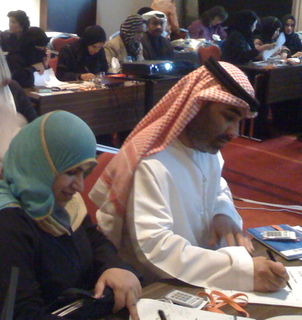You have no problem with class control when you wanted it. – I suggest you get it as soon as you are ready to start.
Learning cannot go on to any great extent, if half the students are talking.
Climb on them and let them know what you expect.
Dedicated to relinquishing responsibility for learning to the students
You have no problem with class control when you wanted it. – I suggest you get it as soon as you are ready to start.
Learning cannot go on to any great extent, if half the students are talking.
Climb on them and let them know what you expect.
 Last week I presented at the TeachME 2009 International Education Conference, in Dubai. It was a great pleasure to meet dedicated educators from across the Gulf Coast region.
Last week I presented at the TeachME 2009 International Education Conference, in Dubai. It was a great pleasure to meet dedicated educators from across the Gulf Coast region. Faced with writing a school report on an Australian animal, Tyler Kennedy began where many student begin these days: by searching the Internet. But Tyler didn’t use Google or Yahoo. He searched for information about the platypus on YouTube.
“I found some videos that gave me pretty good information about how it mates, how it survives, what it eats,” Tyler said. Similarly, when Tyler gets stuck on one of his favorite games on the Wii, he searches YouTube for tips on how to move forward. And when he wants to explore the ins and outs of collecting Bakugan Battle Brawlers cards, which are linked to a Japanese anime television series, he goes to YouTube again.
While he favors YouTube for searches, he said he also turns to Google from time to time.
“When they don’t have really good results on YouTube, then I use Google,” said Tyler, who is 9 and lives in Alameda. Calif.
Confronted with modern teaching techniques, educators have some thorny issues to sort through and a portfolio of skills to adopt in their quest to ensure lifelong learning. Today’s teachers must motivate students to read, seek knowledge, initiate activities that catalyze their curiosity, engage them in debates, innovate when resources are scarce, stimulate their senses and drive to explore, make it rewarding for them to investigate, captivate their interest in networking and get them to cooperate together towards a common and worthwhile purpose. Experts at the TeachME 2009 Conference will gear their efforts towards focusing their workshops around these themes adding inspiration to education in an innovative approach.
At M.I.T., two introductory courses are still required — classical mechanics and electromagnetism — but today they meet in high-tech classrooms, where about 80 students sit at 13 round tables equipped with networked computers.
Instead of blackboards, the walls are covered with white boards and huge display screens. Circulating with a team of teaching assistants, the professor makes brief presentations of general principles and engages the students as they work out related concepts in small groups.
Teachers and students conduct experiments together. The room buzzes. Conferring with tablemates, calling out questions and jumping up to write formulas on the white boards are all encouraged.
“There was a long tradition that what it meant to teach was to give a really well-prepared lecture,” said Peter Dourmashkin, a senior lecturer in physics at M.I.T. and a strong proponent of the new method. “It was the students’ job to figure it out.”
The problem, say Dr. Dourmashkin and others in the department, is that a lot of students had trouble doing that. The failure rate for those lecture courses, even those taught by the most mesmerizing teachers, was typically 10 percent to 12 percent. Now, it has dropped to 4 percent.
… The traditional 50-minute lecture was geared more toward physics majors, said Eric Mazur, a physicist at Harvard who is a pioneer of the new approach, and whose work has influenced the change at M.I.T.
“The people who wanted to understand,” Professor Mazur said, “had the discipline, the urge, to sit down afterwards and say, ‘Let me figure this out.’ ” But for the majority, he said, a different approach is needed.
“Just as you can’t become a marathon runner by watching marathons on TV,” Professor Mazur said, “likewise for science, you have to go through the thought processes of doing science and not just watch your instructor do it.”